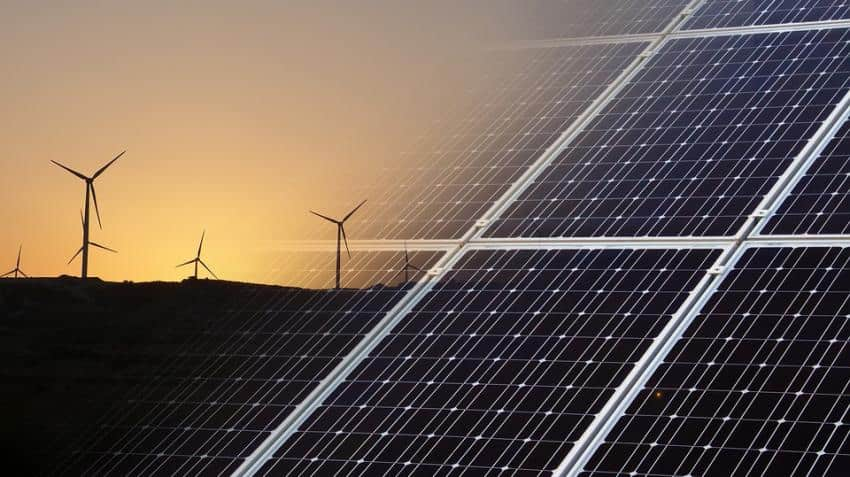India needs over $200 billion of investment in renewable infrastructure
India`s decarbonisation policy is in line with global trends which, since 2011, have been seeing investments in renewable energy infrastructure running at two-three times of that for new fossil fuel capacities, Tim Buckley, Director of Energy Finance Studies Australasia with the Institute for Energy Economics and Financial Analysis (IEEFA), said.

India is on track to catalyse $200-300 billion of new investment in its renewable energy infrastructure in the next decade with global capital inflows playing an increasingly crucial role, a top financial analyst with a leading US-based institute foresees.
India`s decarbonisation policy is in line with global trends which, since 2011, have been seeing investments in renewable energy infrastructure running at two-three times of that for new fossil fuel capacities, Tim Buckley, Director of Energy Finance Studies Australasia with the Institute for Energy Economics and Financial Analysis (IEEFA), said.
At present, India relies on thermal power generation for 80 per cent of its electricity, while hydro supplies a significant 10 per cent and renewables just seven per cent.
However, India has set an ambitious but achievable national target of 275 GW of renewable capacity installed by 2027.
Changes to tap renewable resources are on the way.
Indeed, the tipping point may have been 2016-17, when the net thermal capacity plummeted and renewable installs more than doubled, Buckley said in his report "Indian electricity sector transformation" made public on Tuesday.
These developments continued into 2017 with costs of both falling by an unprecedented 50 per cent and recent tenders now pricing renewables at 20 per cent below the average price on existing Indian thermal power generation.
The report examines the rapid transformation in India`s electricity market, showing how renewable energy and energy efficiency measures can help the country minimise the growth of coal-fired electric generation.
Electricity demand in India is expected to double over the coming decade, and how this electricity will be generated is important for both India and the world.
"We present an electricity sector model out to 2027 showing how India can meet almost all of its growing electricity needs via increasingly cost-competitive renewable energy resources and numerous energy efficiency measures, while at the same time keeping its coal use in check, at perhaps no more than five-10 per cent above current levels,"
Buckley told IANS in an email response.
India is the world`s second-largest producer, consumer and importer of thermal coal. It`s also the third largest electricity user in the world after China and the US.
Toeing the path of developing renewable energy infrastructure, prices of both wind and solar power have recently fallen significantly in India with record low prices seen this year.
As a result, for the first time in India, addition of new renewable generation topped that of thermal power in 2016-17.
During this period, net thermal power addition fell to just 7.7 gigawatts, well below the roughly 20 GW added annually in the prior four years, while renewable additions jumped to 15.7 GW, the report said.
India`s draft national electricity plan calls for renewable energy installs to average 21-22 GW annually going forward.
Given the rapidly improving economics of renewable, solar`s cost is down 50 per cent in just two years, for example hovering at about $0.038 per kilowatt-hour, making this an achievable target.
Some in India have been concerned about rising module prices in the near term, but IEEFA pointed to the record low $0.018 and $0.021/kWh tariffs awarded in Mexico and Chile respectively this past week.
Clearly India can look forward to further renewable energy tariff reductions medium term, the report said.
While renewables are expected to surge, IEEFA forecasts that net thermal power capacity additions are likely to remain below five GW annually in the next decade, held in check by increased retirements of highly polluting, end-of-life sub-critical coal-fired power plants.
"We expect retirements to average more than 2.5 GW annually, but with coal-fired power plant utilisation rates averaging just 56.7 per cent in 2016-17 and little prospect of this improving over the coming decade, retirements could well accelerate to four-five GW annually," said Buckley.
These retirements are likely to be pushed forward by the reality that solar and wind already are being deployed at tariffs below those of even existing domestic thermal power generation.
India`s target to all but cease thermal coal imports by the end of this decade is now the logical economic outcome, especially since plants using expensive imported coal are increasingly the high-cost dispatch option.
As the second largest importer of thermal coal globally, this is a materially adverse development for nations exporting thermal coal.
"The challenges to integrating India`s 40 per cent renewable energy target by 2030 are real, but the momentum over the past three years, gained through government policy and economic merit, give us confidence India will stay the course," the report said.
India is ranked 14th in the Climate Change Performance Index (CCPI) 2018 out of 56 nations and the European Union by environmental organisation Germanwatch, an improvement from its 20th position last year, for reducing greenhouse gas emissions by opting to transform its electricity sector towards green technology.
China, with its high emissions and growing energy use over the past five years, still ranks 41st, says the Germanwatch`s report released last week.
At the just-concluded UN Climate Change Conference (COP23) in Bonn, a coalition led by Canada and Britain jointly launched the Powering Past Coal Alliance with more than 20 partners, and even a US state, to move away from coal, a major source of air pollution.
A climate expert told IANS that this is a first-of-its-kind attempt to phase out the traditional coal power on such a massive scale after the 2015 Paris Climate Change Agreement that aims to keep global warming within 1.5 degrees Celsius by cutting greenhouse gases from burning fossil fuels.
Get Latest Business News, Stock Market Updates and Videos; Check your tax outgo through Income Tax Calculator and save money through our Personal Finance coverage. Check Business Breaking News Live on Zee Business Twitter and Facebook. Subscribe on YouTube.
RECOMMENDED STORIES

after bumper 2024 rs 2 lakh crore worth ipos expected in 2025 primary market nsdl avanse financial ecom express sebi approval

Latest SBI Senior Citizen FD Rates: How much senior citizens can get on investments of Rs 5,55,555, Rs 7,77,777, and Rs 9,99,999 in Amrit Vrishti, 1-, 3-, and 5-year FDs

Rs 1,000 Monthly SIP for 40 Years vs Rs 10,000 Monthly SIP for 20 Years: Which can give you higher corpus in long term? Calculations inside

Power of Compounding: How can you create Rs 5 crore, 6 crore, 7 crore corpuses if your monthly salary is Rs 20,000?

Power of Rs 3,000 SIP: In how many years, Rs 3,000 monthly investment can generate corpuses of Rs 2 crore and Rs 3 crore? Know here
02:08 PM IST








 India to continue resilient growth in 2025, RBI may do modest interest rate easing: S&P
India to continue resilient growth in 2025, RBI may do modest interest rate easing: S&P Relentless FII sellings now over as Indian economy remains resilient
Relentless FII sellings now over as Indian economy remains resilient Fiscal deficit at 46.5% of full-year target at Oct-end: Government data
Fiscal deficit at 46.5% of full-year target at Oct-end: Government data $8 trillion of $14 trillion invested in India since 1947 came in last 10 years
$8 trillion of $14 trillion invested in India since 1947 came in last 10 years Private consumption driving growth in Q3 with rural India taking lead: RBI
Private consumption driving growth in Q3 with rural India taking lead: RBI